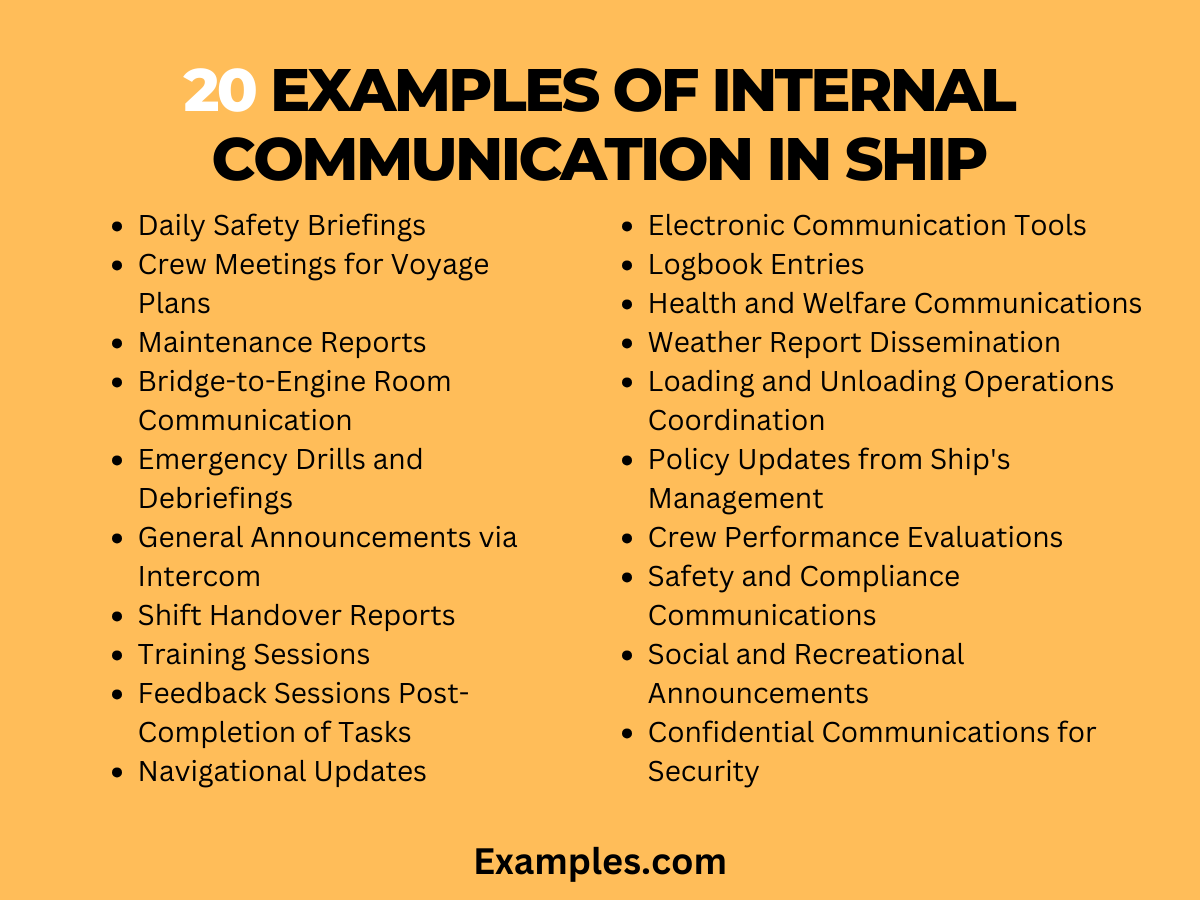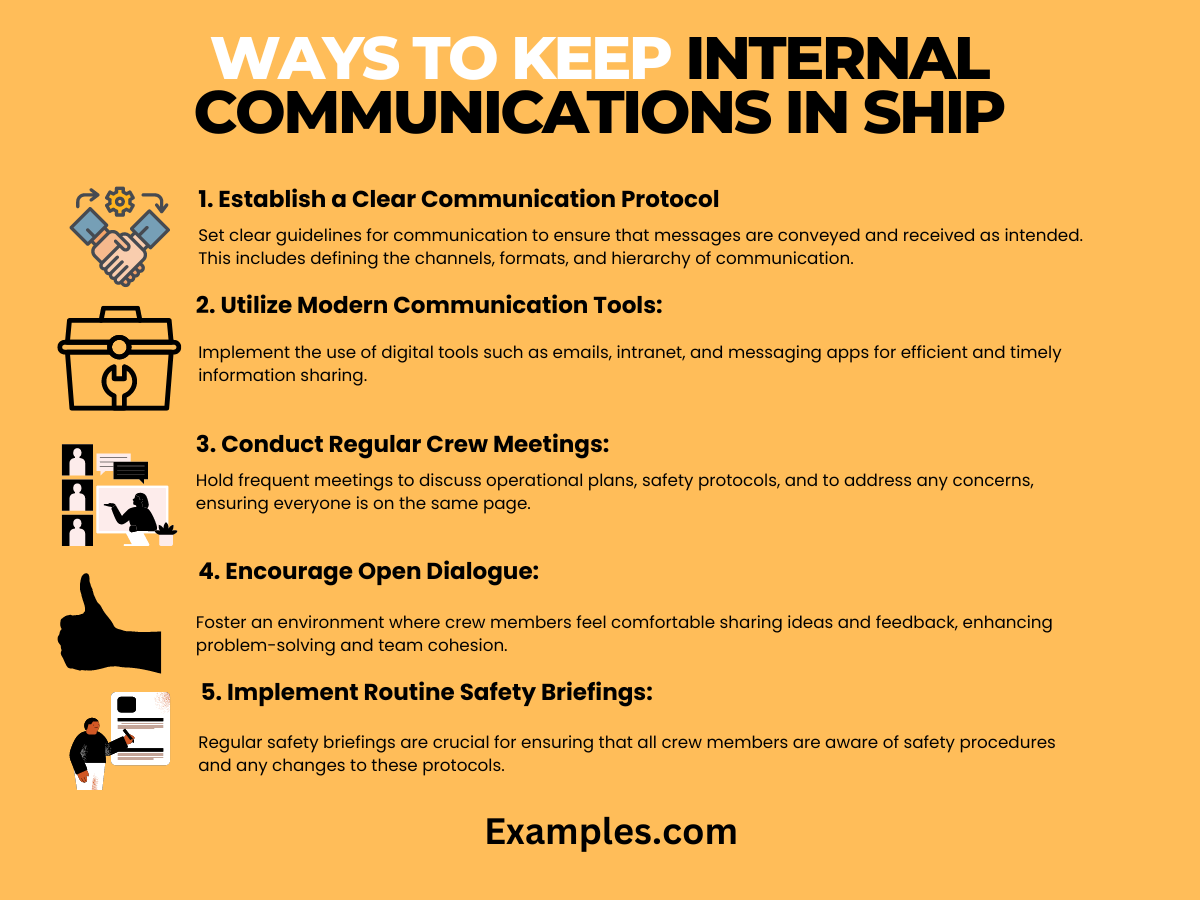Internal communication in a ship is a vital component for efficient maritime operations. This complete guide delves into various aspects of onboard communication, providing practical Internal Communication Examples and insights. From daily briefings to emergency protocols, understanding these communication methods enhances crew coordination and safety. Emphasizing the importance of effective internal communication, this guide offers a comprehensive overview of the types, functions, and best practices essential for maritime professionals. Explore how internal communication shapes the dynamics of ship operations in this insightful guide.
What is Internal Communication in Ship? – Definition

Internal communication in a ship refers to the processes and methods used to share information and coordinate activities among crew members and departments aboard a vessel. It involves a range of communication forms, from formal meetings and written reports to informal discussions and digital messages. Effective internal communication is crucial for ensuring safety, efficiency, and smooth operations at sea. It includes everything from daily operational briefings to emergency response communications. This concept is an integral part of Internal Communication Functions and Internal Communication Techniques, playing a key role in the overall management and success of maritime operations.
20 Examples of Internal Communication in Ship
Internal communication in a ship encompasses various forms, from digital messages to face-to-face meetings, each critical for maintaining safety and operational efficiency. These examples highlight the diversity and importance of communication methods aboard. They demonstrate how effective communication aids in decision-making, problem-solving, and crew welfare. Let’s explore these Internal Communication Examples and Internal Communication Techniques to understand their impact on maritime operations.

- Daily Safety Briefings: Every morning, the crew gathers for a briefing where the captain discusses safety protocols.
Example: “Today’s focus is on deck safety. Ensure all equipment is secured.” - Crew Meetings for Voyage Plans: Regular meetings to discuss and update the voyage plans.
Example: “Our next port of call has specific docking requirements. Let’s review them together.” - Maintenance Reports: Communication between engineering and deck departments regarding equipment maintenance.
Example: “The main engine maintenance is completed and fully operational.” - Bridge-to-Engine Room Communication: Essential during maneuvers for coordinating actions.
Example: “Engine room, we need to adjust our speed for upcoming harbor entry.” - Emergency Drills and Debriefings: Conducting drills and discussing outcomes to improve safety responses.
Example: “Let’s review the drill. What went well, and where can we improve?” - General Announcements via Intercom: Using intercom systems to make ship-wide announcements.
Example: “Attention all crew, please assemble in the mess hall for a brief meeting.” - Shift Handover Reports: Exchanging crucial information during shift changes. Example: “The port side winch is currently under repair; use the starboard side as an alternative.”
- Training Sessions: Sharing knowledge on new equipment or protocols.
Example: “This training session is focused on our new navigation system. Let’s start with its basic functions.” - Feedback Sessions Post-Completion of Tasks: Discussing completed tasks to gather feedback.
Example: “Let’s discuss the loading process. How can we optimize it next time?” - Navigational Updates: Keeping the crew informed about navigational aspects.
Example: “The current sea state requires a change in our navigational route.” - Electronic Communication Tools: Using emails and messaging apps for quick updates.
Example: “Please check your email for the updated safety guidelines.” - Logbook Entries: Recording significant events for future reference.
Example: “Ensure all navigational changes are accurately logged with timestamps.” - Health and Welfare Communications: Addressing crew health issues.
Example: “A health and wellness session will be conducted this evening for all crew members.” - Weather Report Dissemination: Sharing weather updates with relevant departments.
Example: “Severe weather alert for our area. Let’s prepare accordingly.” - Loading and Unloading Operations Coordination: Communicating during cargo operations.
Example: “All hands on deck for smooth unloading operations at the next port.” - Policy Updates from Ship’s Management: Informing crew about changes in policies.
Example: “There’s an update in our waste management policy, effective immediately.” - Crew Performance Evaluations: Providing feedback on crew performance.
Example: “Your recent performance has been exceptional, particularly in emergency response.” - Safety and Compliance Communications: Ensuring adherence to safety and regulations.
Example: “Reminder: All crew must complete the new safety compliance training by Friday.” - Social and Recreational Announcements: Enhancing crew morale with social activities.
Example: “Join us tonight for a movie screening in the lounge area.” - Confidential Communications for Security: Discussing sensitive security protocols.
Example: “Team leaders, please attend the confidential security briefing at 1400 hours.”
These examples highlight the multifaceted nature of internal communication in a ship, underscoring its importance in ensuring a well-coordinated and safe maritime environment.
10 Ways to Keep Internal Communications in Ship
Effective internal communication is essential for the smooth operation and safety of a ship. It encompasses various strategies and methods, each playing a vital role in the day-to-day management and emergency response scenarios. This guide will explore 10 key ways to enhance and maintain efficient internal communications in a maritime environment, focusing on strategies that are crucial for Internal Communication in Ship.

- Establish a Clear Communication Protocol: Set clear guidelines for communication to ensure that messages are conveyed and received as intended. This includes defining the channels, formats, and hierarchy of communication.
- Utilize Modern Communication Tools: Implement the use of digital tools such as emails, intranet, and messaging apps for efficient and timely information sharing.
- Conduct Regular Crew Meetings: Hold frequent meetings to discuss operational plans, safety protocols, and to address any concerns, ensuring everyone is on the same page.
- Encourage Open Dialogue: Foster an environment where crew members feel comfortable sharing ideas and feedback, enhancing problem-solving and team cohesion.
- Implement Routine Safety Briefings: Regular safety briefings are crucial for ensuring that all crew members are aware of safety procedures and any changes to these protocols.
- Use Visual Aids for Communication: Employ signs, symbols, and visual guides, especially for safety and procedural information, to overcome language barriers and ensure clear understanding.
- Promote Cross-Departmental Communication: Encourage communication between different departments to facilitate better understanding and teamwork across the ship.
- Provide Training on Communication Skills: Offer training sessions focused on effective communication techniques, emphasizing clarity, listening skills, and conflict resolution.
- Leverage Public Address Systems for Announcements: Use the ship’s PA system for making general announcements or for communicating critical information quickly to the entire crew.
- Establish Feedback Mechanisms: Create channels for feedback to allow crew members to express concerns, suggestions, and observations, which can lead to improvements in communication practices.
By implementing these strategies, Internal Communication in Ship can be significantly improved, leading to enhanced safety, efficiency, and crew morale. These methods, rooted in best practices of Internal Communication Techniques, ensure that all crew members are informed, engaged, and prepared for both routine operations and unexpected challenges at sea.
Types of Internal Communication in Ship
In the specialized context of maritime operations, understanding the various types of internal communication in a ship is crucial. These communication forms are designed to address the unique challenges and requirements of life at sea, ensuring operational efficiency, crew safety, and effective management.
- Formal Meetings and Reports: Scheduled meetings, such as safety briefings and operational debriefs, provide structured opportunities for discussing critical issues. Detailed reports offer documented insights into various aspects of ship operations, from maintenance to crew performance. This formal avenue of communication ensures that all crew members are aligned with the ship’s operational goals and safety protocols.
- Informal Conversations: Unstructured, casual interactions among crew members are invaluable for fostering a sense of community and teamwork. These conversations can lead to the spontaneous exchange of ideas and experiences, enhancing problem-solving and decision-making processes on board.
- Digital Communications: The advent of digital technology has revolutionized communication in ships. Utilization of emails, internal messaging apps, and electronic bulletin boards enables swift and efficient sharing of information, from weather updates to shift schedules, ensuring the crew remains well-informed and connected.
- Public Address Announcements: For immediate and ship-wide communication, public address systems are indispensable. They are primarily used for broadcasting urgent updates, emergency alerts, and general announcements, ensuring that vital information reaches every crew member promptly.
- Visual Communication: Visual tools like signage, safety posters, and instructional infographics are critical, especially in conveying safety procedures and compliance guidelines. This form of communication is effective in overcoming language barriers and providing clear, unambiguous instructions.
- Written Documents: Essential written materials such as logbooks, training manuals, and compliance policies play a significant role. They provide a permanent record of operations, instructions, and guidelines, serving as a reference for both current and future crew members.
These diverse communication types are integral to the Internal Communication Functions in a ship, playing a vital role in ensuring a cohesive, informed, and safe maritime operation.
How do Internal Ship Communications Work?
The effectiveness of internal communications in a ship is a key factor in its smooth and safe operations. The communication system aboard a vessel is a well-orchestrated network of various methods, each serving specific purposes and collectively ensuring that all members of the crew are aligned and informed.
- Centralized Command and Control: The bridge functions as the nerve center of the ship, where the captain and officers coordinate all aspects of navigation and operations. This centralized command structure ensures that instructions and information flow seamlessly to the appropriate departments.
- Use of Technology: Modern ships are equipped with sophisticated communication technologies such as VHF radios, satellite communications, and intercom systems. These tools ensure real-time, reliable communication across different areas of the ship, vital for operational coordination and emergency responses.
- Structured Reporting Systems: Regular logging and reporting mechanisms, such as daily logs and maintenance reports, provide a structured approach to information sharing. These systems ensure continuity and consistency in operations, facilitating smooth handovers and informed decision-making.
- Emergency Communication Protocols: In emergencies, robust communication protocols are crucial. These include alarm systems, emergency communication channels, and predefined procedures, which are regularly drilled to ensure quick and effective crew mobilization and response.
- Training and Drills: Regular training sessions and drills are conducted to familiarize the crew with communication tools and emergency procedures. This training is vital for ensuring that every crew member can effectively communicate and respond in various scenarios.
- Feedback Mechanisms: Open channels for feedback, such as suggestion boxes or digital forums, encourage active participation from the crew in improving communication practices. This feedback loop is essential for identifying areas of improvement and fostering a culture of continuous learning and development.
Through the integration of these communication methods, Internal Ship Communications function as a cohesive and efficient system. It plays a crucial role in navigating the complexities of maritime operations and ensuring a safe, efficient, and well-coordinated journey.
In conclusion, effective internal communication in a ship is pivotal for ensuring safety, operational efficiency, and crew cohesion. This guide has provided insights into various communication types and methods aboard a vessel, emphasizing their importance in maritime operations. By adopting these communication strategies and tips, maritime professionals can significantly enhance onboard communication, leading to a more informed, efficient, and safer maritime environment.



